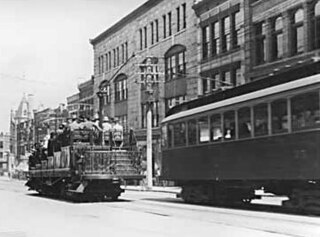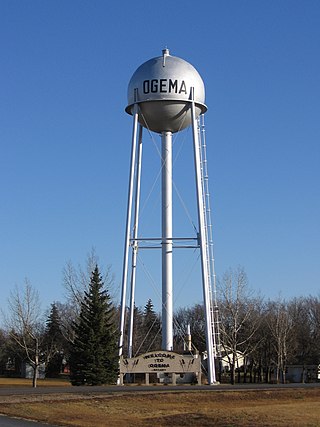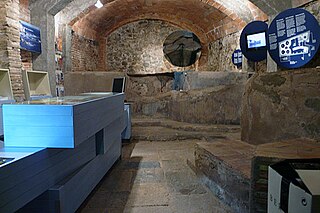
Richmond is a city in the coastal Lower Mainland region of British Columbia, Canada. It occupies almost the entirety of Lulu Island, between the two estuarine distributaries of the Fraser River. Encompassing the adjacent Sea Island and several other smaller islands and uninhabited islets to its north and south, it neighbours Vancouver and Burnaby on the Burrard Peninsula to the north, New Westminster and Annacis Island to the east, Delta to the south, and the Strait of Georgia to the west.

The British Columbia Electric Railway (BCER) was an historic railway which operated in southwestern British Columbia, Canada. Originally the parent company for, and later a division of, BC Electric Company, the BCER assumed control of existing streetcar and interurban lines in southwestern British Columbia in 1897, and operated the electric railway systems in the region until the last interurban service was discontinued in 1958. During and after the streetcar era, BC Electric also ran bus and trolleybus systems in Greater Vancouver and bus service in Greater Victoria; these systems subsequently became part of BC Transit, and the routes in Greater Vancouver eventually came under the control of TransLink. Trolley buses still run in the City of Vancouver with one line extending into Burnaby.

Hazelton is a village municipality in the Skeena region of west central British Columbia, Canada. The place is on the southeast side of the Skeena River immediately north of the Bulkley River mouth, where the confluence forms a peninsula. On BC Highway 62, the locality is by road about 75 kilometres (47 mi) northwest of Smithers and 144 kilometres (89 mi) northeast of Terrace. Hazelton is the original of the "Three Hazeltons", the other two being New Hazelton to the southeast and South Hazelton to the south.
Steveston, founded in the 1880s, is a neighbourhood of Richmond in Metro Vancouver. On the southwest tip of Lulu Island, the village is a historic port and salmon canning centre at the mouth of the South Arm of the Fraser River. The early 1900s style architecture attracts both the film and tourism industries.

Courtenay is a city of about 26,000 on the east coast of Vancouver Island, in the Canadian province of British Columbia. It is the largest community and only city in the area commonly known as the Comox Valley, and the seat of the Comox Valley Regional District, which replaced the Comox-Strathcona Regional District. Courtenay is 4 km (2.5 mi) west of the town of Comox, 7 km (4.3 mi) northeast of the village of Cumberland, 5 km (3.1 mi) northwest of the unincorporated settlement of Royston, and 108 km (67 mi) northwest of Nanaimo. Along with Nanaimo and Victoria, it is home to The Canadian Scottish Regiment, a Primary Reserve infantry regiment of the Canadian Armed Forces.

Southampton is a community on the shores of Lake Huron in Bruce County, Ontario, Canada. It is close to Port Elgin and is located at the mouth of the Saugeen River in the Saugeen Ojibway Nation Territory. The size of the town is 6.44 square kilometres. The permanent population in 2016 was 3,678, but the summer population is higher since cottagers and campers spend vacation time in the area.
Heritage Park Historical Village is a historical park in Calgary, Alberta, Canada, on 127 acres (51 ha) of parkland on the banks of the Glenmore Reservoir, in the city's southwestern quadrant. The Historical Village part of the park is open 7 days a week (10-5) from the Canadian May long weekend through to the September Labour Day long weekend, and then weekends from Labour Day through to Canadian Thanksgiving weekend in mid October. Gasoline Alley Museum and the Railway Café are open year-round. As one of Canada's largest living history museums, it is one of the city's most visited tourist attractions. Exhibits span western Canadian history from the 1860s to the 1950s. Many of the buildings are historical and were transported to the park to be placed on display. Others are re-creations of actual buildings. Most of the structures are furnished and decorated with genuine artifacts. Staff dress in historic costume, and antique automobiles and horse-drawn vehicles service the site. Calgary Transit provides regular shuttle service from Heritage C-Train station. The park opened on July 1, 1964.

The Rooms is a cultural facility in St. John's, Newfoundland and Labrador, Canada. The facility opened in 2005 and houses the Art Gallery of Newfoundland and Labrador, the Provincial Archives of Newfoundland and Labrador and the Provincial Museum of Newfoundland and Labrador.
Harold Steves is a Canadian politician. Steves is a longtime city councillor on Richmond, British Columbia City Council, first elected in 1969 and re-elected in 1977, after serving one term as the New Democratic Party of British Columbia MLA from 1972 to 1975.

Ogema is a town in south central Saskatchewan, Canada. It is approximately 115 kilometres (71 mi) south of Saskatchewan's capital city, Regina, and about midway between Weyburn and Assiniboia on Highway 13.

The Burnaby Village Museum, previously known as the Heritage Village, is an open-air museum in Burnaby, British Columbia, Canada, located at Deer Lake Park. It is open seasonally from May to September and opens for special events taking place September to March. The Burnaby Village Museum is a reconstructed 1920s village, containing 31 full scale buildings; its costumed staff demonstrate traditional trades. The museum spans 10 acres (4 ha) of land. Some of the buildings are original heritage buildings, moved from other locations in the community and restored. Others are replica buildings, created to house specific displays and artifacts, including a 1912 B.C. Electric Railway interurban tram. The museum is also known for the 1912 C. W. Parker Carousel, available for visitors to ride.

The Gulf of Georgia Cannery is a National Historic Site of Canada located in Steveston village in Richmond, British Columbia.
The history of the Jews in Vancouver in British Columbia, Canada has been noted since the mid-19th century.

Hastings Fishermen's Museum is a museum dedicated to the fishing industry and maritime history of Hastings, a seaside town in East Sussex, England. It is housed in a former church, officially known as St Nicholas' Church and locally as The Fishermen's Church, which served the town's fishing community for nearly 100 years from 1854. After wartime damage, occupation by the military and subsequent disuse, the building was leased from the local council by a preservation society, which modified it and established a museum in it. It opened in 1956 and is now one of the most popular tourist attractions in the town and borough of Hastings. The building, a simple Gothic Revival-style stone chapel, has been listed at Grade II by English Heritage for its architectural and historical importance.

The Brighton Fishing Museum is a registered independent museum established in co-operation with the local fishing community in 1994. This museum is dedicated to Brighton's fishing and seaside history. It is located a short distance to the west of Brighton Pier within an area known as the Fishing Quarter, occupying two of the arches on the Kings' Road, which runs along Brighton's beachfront. Admission is free and donations appreciated.

The Grand Manan Museum is located in Grand Harbour on Grand Manan Island, New Brunswick, Canada. The Museum collects, preserves and displays pieces that represent the history of the Village and Island. Through programs and exhibits, the museum encourages an appreciation for the community heritage, culture and physical environment. The Museum houses more than 18 permanent exhibits, including the notable Allan Moses Bird Gallery which has over 300 taxidermy birds. The Museum has a tax-free gift shop which contains many handmade and interesting items that have a connection with the island such as prints, wood carvings and a vast selection of postcards by local artists and photographers.

Sa Perola is the net dyeing house of the Fisherman's Guild at Saint Piere. It is located in Carrer de les Voltes de Calella de Palafrugell. Documentation of the dyeing centre was preserved by the same producer until his entrance to the Municipal File of Palafrugell.
Tomekichi "Tomey" Homma (1865–1945) was a Canadian who was one of the first Japanese settlers of Steveston, which is now part of Richmond, British Columbia. He fought for the right to vote for Japanese-Canadians in provincial elections.

The North Pacific Cannery (NPC) located near Port Edward, British Columbia, Canada, is one of the longest standing canneries in the Port Edward area. NPC was founded in 1889 by Angus Rutherford Johnston, John Alexander Carthew, and Alexander Gilmore McCandless. The plant stopped processing salmon in 1968, becoming a reduction plant until its closure in 1981 after 80 years of operations.

The history of Japanese people in British Columbia began with the arrival of Manzo Nagano in New Westminster in 1877. Prior to 1942, British Columbia was home to 90% of all Japanese in Canada. In 2001, 44% of all Japanese Canadians lived in British Columbia, or about 1% of the province's total population.
















